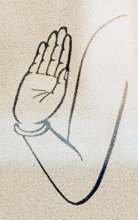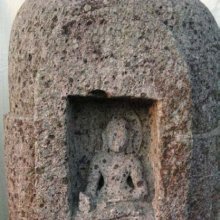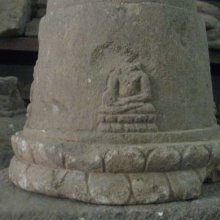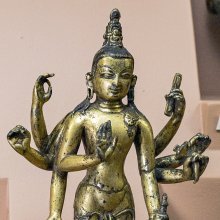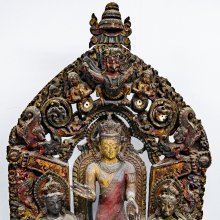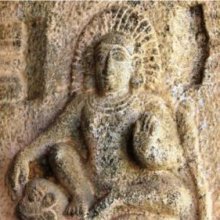Abhayamudra, Abhaya-mudra, Abhayamudrā: 11 definitions
Introduction:
Abhayamudra means something in Buddhism, Pali, Hinduism, Sanskrit, the history of ancient India, Marathi. If you want to know the exact meaning, history, etymology or English translation of this term then check out the descriptions on this page. Add your comment or reference to a book if you want to contribute to this summary article.
Images (photo gallery)
(+24 more images available)
In Hinduism
Shilpashastra (iconography)
Source: Wisdom Library: Śilpa-śāstraAbhayamudrā (अभयमुद्रा) is a Sanskrit word referring to “the gesture of fearlessness”. The term mudrā translates to “hand seal”.
Source: Google Books: The Book of Hindu Imagery: Gods, Manifestations and Their MeaningAbhaya(-mudra)—The right hand raised with the palm of the hand facing forwards. This indicates blessing, protection and reassurance.
Source: Red Zambala: Hindu Icons and Symbols | TrinityThe Gesture of Fearlessness (Abhaya mudra).—The left hand is held up in this gesture of dispelling fear. Our greatest fear is that of death and personal annihilation. The upheld hand is Śiva’s assurance of protection and preservation. It also indicates the necessity of cultivating harmlessness (ahiṃsā) and affording the gift of fearlessness to all other beings that we encounter.

Shilpashastra (शिल्पशास्त्र, śilpaśāstra) represents the ancient Indian science (shastra) of creative arts (shilpa) such as sculpture, iconography and painting. Closely related to Vastushastra (architecture), they often share the same literature.
Pancaratra (worship of Nārāyaṇa)
Source: SriMatham: Vaiṣṇava Iconology based on Pañcarātra ĀgamaAbhaya Mudra (“The Gesture of Fearlessness”):—This mudra indicates that we should never entertain feelings of fear vis-à-vis God. Vishnu/Narayana is the ocean of compassion and perfect justice and thus there is nothing to fear from Him. It also reminds us that we should never be the caus e of fear to any other living being. Fear is the first obstacle in the path of spiritual development

Pancaratra (पाञ्चरात्र, pāñcarātra) represents a tradition of Hinduism where Narayana is revered and worshipped. Closeley related to Vaishnavism, the Pancaratra literature includes various Agamas and tantras incorporating many Vaishnava philosophies.
Purana and Itihasa (epic history)
Source: archive.org: Shiva Purana - English TranslationAbhayamudrā (अभयमुद्रा) is the name of a gesture (mudrā) mentioned in the Śivapurāṇa 1.20, while explaining the mode of worshipping an earthen phallic image (pārthiva-liṅga) according to the Vedic rites:—“[...] he shall show the “Śiva-mudrā” with the mantra ‘Eṣa te’; the Abhayamudrā with the mantra ‘Yato Yataḥ’ etc. and the Jñāna-mudrā with the Tryambaka-mantra”.

The Purana (पुराण, purāṇas) refers to Sanskrit literature preserving ancient India’s vast cultural history, including historical legends, religious ceremonies, various arts and sciences. The eighteen mahapuranas total over 400,000 shlokas (metrical couplets) and date to at least several centuries BCE.
General definition (in Hinduism)
Source: Srimatham: Hindu IconologyAbhaya Mudra — the gesture of fearlessness — the palm displayed with the fingers pointing to the sky. Indicates the practice of harmlessness to all beings in word, deed and thought (ahimsa) and granting to all beings the gift of freedom from fear.
In Buddhism
General definition (in Buddhism)
Source: Exotic India: Mudras of the Great BuddhaAbhaya in Sanskrit means fearlessness. Thus this mudra symbolizes protection, peace, and the dispelling of fear. It is made with the right hand raised to shoulder height, the arm crooked, the palm of the hand facing outward, and the fingers upright and joined. The left hand hangs down at the side of the body. In Thailand, and especially in Laos, this mudra is associated with the movement of the walking Buddha (also called 'the Buddha placing his footprint'). It is nearly always used in images showing the Buddha upright, either immobile with the feet joined, or walking.
This mudra, which initially appears to be a natural gesture, was probably used from prehistoric times as a sign of good intentions - the hand raised and unarmed proposes friendship, or at least peace; since antiquity, it was also a gesture asserting power, as with the magna manus of the Roman Emperors who legislated and gave peace at the same time.
In Gandhara art, this mudra was sometimes used to indicate the action of preaching. This is also the case in China where it is very commonly found in images of the Buddha, mainly in the Wei and Sui eras (fourth to seventh centuries).
The Abhaya mudra is displayed by the fifth Dhyani Buddha, Amoghasiddhi. He is also the Lord of Karma in the Buddhist pantheon. Amoghasiddhi helps in overcoming the delusion of jealousy. By meditating on him, the delusion of jealousy is transformed into the wisdom of accomplishment. This transformation is hence the primary function of the Abhaya mudra.
India history and geography
Source: Cologne Digital Sanskrit Dictionaries: Indian Epigraphical GlossaryAbhaya-mudrā.—(HA), pose of hand offering protection, in which the palm of the right hand, facing the devotee, is held with fingers upwards. Cf. abhaya-hasta. Note: abhaya-mudrā is defined in the “Indian epigraphical glossary” as it can be found on ancient inscriptions commonly written in Sanskrit, Prakrit or Dravidian languages.

The history of India traces the identification of countries, villages, towns and other regions of India, as well as mythology, zoology, royal dynasties, rulers, tribes, local festivities and traditions and regional languages. Ancient India enjoyed religious freedom and encourages the path of Dharma, a concept common to Buddhism, Hinduism, and Jainism.
Languages of India and abroad
Marathi-English dictionary
Source: DDSA: The Molesworth Marathi and English Dictionaryabhayamudrā (अभयमुद्रा).—f (S) A re-assuring or encouraging countenance (as of an idol or a king).
Source: DDSA: The Aryabhusan school dictionary, Marathi-Englishabhayamudrā (अभयमुद्रा).—f A reassuring countenance.
Marathi is an Indo-European language having over 70 million native speakers people in (predominantly) Maharashtra India. Marathi, like many other Indo-Aryan languages, evolved from early forms of Prakrit, which itself is a subset of Sanskrit, one of the most ancient languages of the world.
Sanskrit dictionary
Source: DDSA: The practical Sanskrit-English dictionaryAbhayamudrā (अभयमुद्रा).—a variety of mudrā in Tantra literature.
Abhayamudrā is a Sanskrit compound consisting of the terms abhaya and mudrā (मुद्रा).
Sanskrit, also spelled संस्कृतम् (saṃskṛtam), is an ancient language of India commonly seen as the grandmother of the Indo-European language family (even English!). Closely allied with Prakrit and Pali, Sanskrit is more exhaustive in both grammar and terms and has the most extensive collection of literature in the world, greatly surpassing its sister-languages Greek and Latin.
See also (Relevant definitions)
Partial matches: Mudra, Abhaya.
Full-text (+33): Abhaya, Abhayahasta, Tarakari, Vidyalakshmi, Dhanyalakshmi, Dhanalakshmi, Adilakshmi, Santanalakshmi, Varadamudra, Viralakshmi, Gajalakshmi, Shivamudra, Patakahasta, Jnanamudra, Mojaghanjabala, Padma, Vishvoshnisha, Vijayalakshmi, Shantasi, Maheshvari.
Relevant text
Search found 24 books and stories containing Abhayamudra, Abhaya-mudra, Abhayamudrā, Abhaya-mudrā; (plurals include: Abhayamudras, mudras, Abhayamudrās, mudrās). You can also click to the full overview containing English textual excerpts. Below are direct links for the most relevant articles:
Jain Remains of Ancient Bengal (by Shubha Majumder)
Appendix 1 - The Position of Yakṣas and Yakṣiṇīs in Jainism
Jain Tutelary Couple or Parents of the Tīrthaṅkaras < [Chapter 6 - Iconographic Study of Jaina Sculptural Remains]
Varahi Tantra (English Study) (by Roberta Pamio)
Chapter 12 - The Dhyānas (supports for the meditation) of the Goddess < [Summary of the Vārāhī Tantra]
Chapter 22 - The the Six Āmnāyas < [Summary of the Vārāhī Tantra]
Chapter 29 - The worship of Caṇḍikā < [Summary of the Vārāhī Tantra]
Sripura (Archaeological Survey) (by Bikash Chandra Pradhan)
Scultures of Vajrapani < [Chapter 3 - Sculptural Programme]
Scultures of Rakta-Lokesvara < [Chapter 3 - Sculptural Programme]
Stone Images (1): Buddhist Images < [Chapter 3 - Sculptural Programme]
Shat-cakra-nirupana (the six bodily centres) (by Arthur Avalon)
Summary of the Viśuddha Cakra (verses 28-31) < [Section 5]
Verse 20 < [Section 3]
Summary (of verses 1-13) < [Section 1]
Abhinaya-darpana (English) (by Ananda Coomaraswamy)
Plate I - The Cosmic Dance of Śiva (naṭarāja) < [Plates]
Plate VII - Hands of Images < [Plates]
The Indian Buddhist Iconography (by Benoytosh Bhattachacharyya)
Related products
